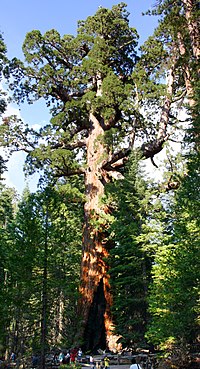
Photo from wikipedia
Abstract Recent drought (2012–2016) caused unprecedented foliage dieback in giant sequoias (Sequoiadendron giganteum), a species endemic to the western slope of the southern Sierra Nevada in central California. As part… Click to show full abstract
Abstract Recent drought (2012–2016) caused unprecedented foliage dieback in giant sequoias (Sequoiadendron giganteum), a species endemic to the western slope of the southern Sierra Nevada in central California. As part of an effort to understand and map sequoia response to droughts, we studied the patterns of remotely sensed canopy water content (CWC), both within and among sequoia groves in two successive years during the drought period (2015 and 2016). Our aims were: (1) to quantify giant sequoia responses to severe drought stress at a landscape scale using CWC as an indicator of crown foliage status, and (2) to estimate the effect of environmental correlates that mediate CWC change within and among giant sequoia groves. We utilized airborne high fidelity imaging spectroscopy (HiFIS) and light detection and ranging (LiDAR) data from the Carnegie Airborne Observatory to assess giant sequoia foliage status during 2015 and 2016 of the 2012–2016 droughts. A series of statistical models were generated to classify giant sequoias and to map their location in Sequoia and Kings Canyon National Parks (SEKI) and vicinity. We explored the environmental correlates and the spatial patterns of CWC change at the landscape scale. The mapped CWC was highly variable throughout the landscape during the two observation years, and proved to be most closely related to geological substrates, topography, and site-specific water balance. While there was an overall net gain in sequoia CWC between 2015 and 2016, certain locations (lower elevations, steeper slopes, areas more distant from surface water sources, and areas with greater climate water deficit) showed CWC losses. In addition, we found greater CWC loss in shorter sequoias and those growing in areas with lower sequoia stem densities. Our results suggest that CWC change indicates sequoia response to droughts across landscapes. Long-term monitoring of giant sequoia CWC will likely be useful for modeling and predicting their population-level response to future climate change.
Journal Title: Forest Ecology and Management
Year Published: 2017
Link to full text (if available)
Share on Social Media: Sign Up to like & get
recommendations!